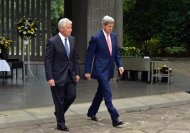
US Secretary of State John Kerry laid a wreath at a
Tokyo cemetery Thursday, in an apparent American attempt to nudge Japan
away from lionising its controversial Yasukuni Shrine.
Kerry and Defense Secretary Chuck Hagel became the most senior
foreign dignitaries to pay their respects at Chidori ga Fuchi, a
cemetery near Tokyo's Imperial Palace, since the Argentine president in
1979, a cemetery official said.Another official told AFP the visit had been instigated by the US and had not come about as a result of a Japanese invitation.
US defence officials said the cemetery was Japan's "closest equivalent" to Arlington National Cemetery.
That view contradicts hawkish Prime Minister Shinzo Abe, who has likened Yasukuni, where 14 "Class A" war criminals are among the 2.5 million enshrined, to the US national cemetery in Virginia.
During a visit to the United States in May, he told Foreign Affairs magazine that the shrine, seen throughout East Asia as a symbol of Japan's militarism, was a tribute to those "who lost their lives in the service of their country".
"I think it's quite natural for a Japanese leader to offer prayer for those who sacrificed their lives for their country, and I think this is no different from what other world leaders do," he said.
Abe, who was also prime minister from 2006 to 2007, has stayed away from the shrine thus far, amid angry denunciations by China and South Korea of visits by his ministers.
Around 100 lawmakers, including three cabinet ministers, went to the shrine on August 15 this year.
While the prime minister stayed away, he sent an offering with an aide.
Unlike Arlington, Yasukuni's caretakers promote a view of history that is controversial even at home, with the accompanying Yushukan museum staunchly defending much of Japan's wartime record.
A US official told media Kerry and Hagel were paying tribute at Chidori ga Fuchi in the same way that "Japanese defence ministers regularly lay wreaths at Arlington".
"This memorial is the closest equivalent. It honours Japanese soldiers, civilians, and support personnel killed on WWII battlefields but whose remains were never recovered by their families. It is a gesture of reconciliation and respect."
Kerry and Hagel signed a guest book at a small pavilion, and placed flowers on a big ceramic coffin located above an underground ossuary in which remains are kept.
Seki Tomoda, an expert on international politics and diplomacy, said the wreath-laying could be Washington's attempt to help East Asia overcome the obstacle caused by the Yasukuni issue, by conferring legitimacy and respectability on Chidori ga Fuchi.
"What's worrying America most is the fierce row among Japan, South Korea and China over the Yasukuni issue," he told AFP.
"Visiting a more neutral place may be a message from Americans... that they want the three countries to ease their confrontation.
"Yasukuni, unlike Arlington, is a religious facility... I think it's impossible that Hagel or any other American leader would visit Yasukuni. Chidori ga fuchi was an option (for the US) in order to send a message."
Chidori ga Fuchi National Cemetery was established in 1959 to house the remains of unidentified Japanese who died overseas during World War II.
The Tokyo memorial, maintained by the environment ministry, honours 358,260 dead, mainly soldiers, whose remains have been returned to Japan, but also some civilians who died overseas.
The prime minister customarily lays a wreath at the cemetery ahead of the formal Japanese service of remembrance held at a large hall in Tokyo.
No comments:
Post a Comment